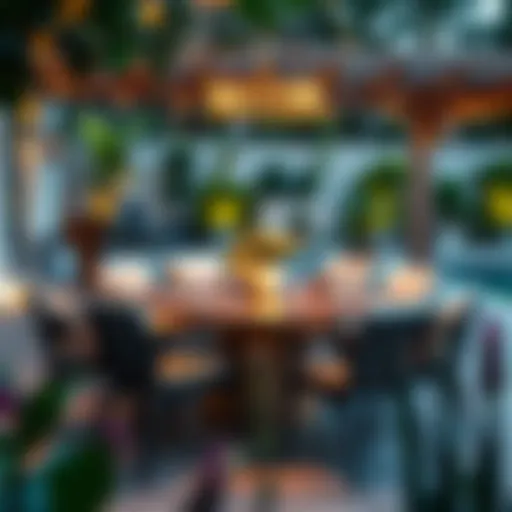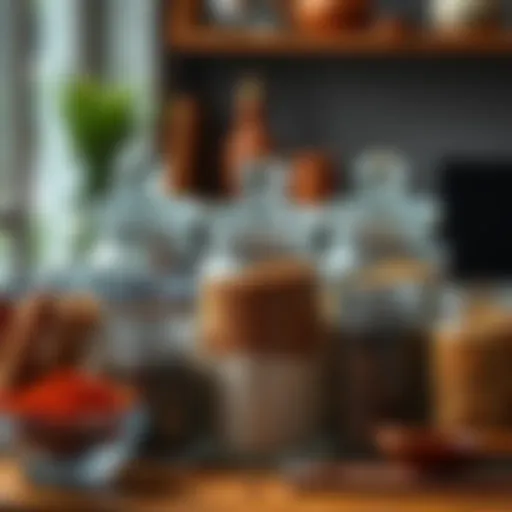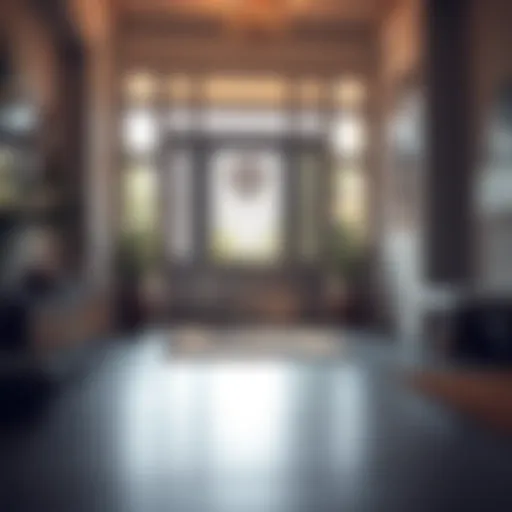Creative Small Window Valance Ideas for Home Decor
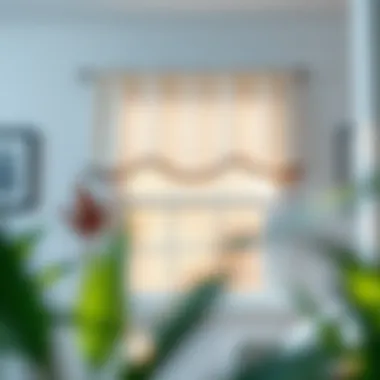

Intro
In the realm of interior design, small window valances often go unnoticed yet they play a substantial role in enriching the overall aesthetic of a space. These decorative elements can transform a modest window treatment into a focal point, adding layers of texture, color, and style. But if you think valances are just for the show, think again; they also serve practical purposes, like adding privacy or light control.
In this article, we are delving deep into creative small window valance ideas that cater to every homeowner's unique taste. From modern minimalism to charming traditional styles, there’s something for everyone. We will not only explore distinct styles but also share tips on choosing the right materials and colors. Plus, there’ll be DIY guidance to ensure you can craft a personalized touch to your window treatments.
Get ready to discover how a simple valance can take your home decor to the next level!
Furniture Styles and Trends
In the age of evolving trends, understanding the nuances of how small window valances align with various furniture styles is key.
Modern vs. Traditional: Understanding the Aesthetics
The contrast between modern and traditional touches creates a fascinating conversation in this space. Modern designs often lean towards sleek lines and geometric patterns. Small tailored valances in solid colors like charcoal or muted tones can seamlessly blend into the backdrop, giving an understated elegance. On the other hand, traditional styles embrace richness and depth, often featuring floral patterns or embellishments that narrate a story.
Here’s a breakdown:
- Modern Valance Styles include:
- Traditional Valance Styles feature:
- Geometric prints
- Solid colors
- Minimalistic materials like linen or cotton voiles
- Ornate fabrics with intricate designs
- Classic floral patterns
- Heavier textiles like brocade or silk
Color and Material Trends: What's In and What's Out
When choosing valances, color and materials can make or break the mood in a room. Currently, earth tones have been making waves. Colors like soft terracotta, muted greens, and sandy beiges work wonders in creating cozy atmospheres. Meanwhile, chic grays give a polished appeal, which satisfies many homeowners.
As for materials, the trend is shifting towards sustainable options. Natural fabrics like organic cotton and hemp are gaining traction, complemented by eco-friendly dyes that keep the aesthetic fresh while being kind to the planet.
Current color/material combo recommendations:
- Earthy tones with organic cotton for a balanced and refined look.
- Rich jewel tones paired with velvet for that touch of luxury.
DIY Valance Ideas
For those feeling crafty, creating your own small window valance can be an engaging project. Simple sewing techniques or even no-sew methods can yield stunning results. Here are a few ideas:
- Fabric Swag Valance: Requires minimal material and can drape beautifully.
- Faux Roman Shades: Easy to make and adds depth to any room.
- Embellished Valance: Adding trims or beads can transform a simple fabric into a statement piece.
Such projects not only customize your decor but also allow for an expression of personal style.
"Small details create the biggest impact. A valance can not only dress up windows; it can dress up a whole room!"
By exploring these various styles and trends, selecting an ideal small window valance doesn’t seem so daunting after all. Whether it's a modern sleek look or a vintage aura you're aiming for, the right valance can enhance your home’s overall decor beautifully.
Preface to Window Valances
In the world of interior design, small window valances often get overshadowed by their more extravagant counterparts like drapes and blinds. However, their contribution to home decor shouldn't be underestimated. Small window valances serve as a delightful middle ground, merging functionality with visual appeal. They can elevate the look of a space without overwhelming it, offering homeowners an opportunity to express personal style while maintaining practicality.
Valances are not merely decorative; they play various roles in enhancing the overall ambiance of a room. They soften hard lines, introduce patterns and textures, and can even help to control light. Moreover, these coverings can frame a window beautifully, drawing the eye naturally and complementing the existing decor. It’s worth noting that the right valance can serve as the cherry on top of your window treatments, bringing everything together coherently.
Definition and Purpose
At its core, a window valance is a short decorative curtain that hangs at the top of a window, often covering the curtain hardware. They can be simple or elaborate, made from a range of materials, colors, and patterns. While their primary function is decorative, they can also fulfill practical roles such as blocking out light or providing some insulation.
In essence, valances add an extra dimension to window treatments. They can act as standalone pieces or complement other window coverings like curtains or blinds. For example, a tailored valance can lend a classic touch over sheer curtains, creating a layered look while adding warmth and elegance.
Historical Context of Window Treatments
Window treatments have been around for centuries, adapting to social trends, material availability, and aesthetic preferences. In ancient times, window coverings were typically heavy and functional, designed to protect against the elements more than to enhance aesthetics. As society evolved, so did the perception of these treatments.
By the 18th century, for instance, window treatments became increasingly ornate, with lavish fabrics taking center stage. During this time, valances emerged as a decorative accent, meant to frame windows and showcase intricate drapery. Fast forward to today, small window valances continue to be an essential element in many homes, providing both charm and a sense of completeness. From Victorian elegance to minimalist styles, the evolution of valances reflects the changing attitudes towards home decor and function.
Benefits of Small Window Valances
When it comes to elevating a home’s interior, small window valances offer more than mere decoration. They serve critical roles that extend beyond aesthetics, providing both charm and utility that every homeowner should consider. Not only can they amplify the decor of any room, but they also create a cohesive look that ties various design elements together. Understanding the advantages of small window valances can enable homeowners, designers, and DIY enthusiasts to make informed decisions about their window treatments. Let’s explore what makes these fabric accents so appealing.
Aesthetic Enhancement
One cannot overlook the visual impact of small window valances. These fabric adornments can dramatically alter the ambiance of a space, acting as the icing on the cake—or the cherry on top, depending on your flavor. Whether they’re cascading softly over rustic kitchen windows or bringing a touch of elegance to a formal dining room, valances are often the perfect finishing touch.
- Visual Texture: Valances introduce layers, creating depth and intrigue where there was none. Different fabrics allow for a variety of textures, like the luxuriously smooth feel of silk versus the more casual vibe of cotton.
- Color Pop: They can introduce vibrant colors, balancing neutral walls or complementing patterned upholstery. For instance, a bright, floral valance can lift the mood of an otherwise drab room, making it feel inviting and fresh.
- Style Cohesion: Small valances blend seamlessly with other decor elements, whether you opt for a minimalist approach with sleek lines or embrace a cozy, bohemian style filled with textures and colors. They create a visual bridge between the outdoors and the indoors, subtly framing the view while enhancing overall design.
Ultimately, these small window treatments harness the power of design to breathe new life into spaces that may feel stagnant.
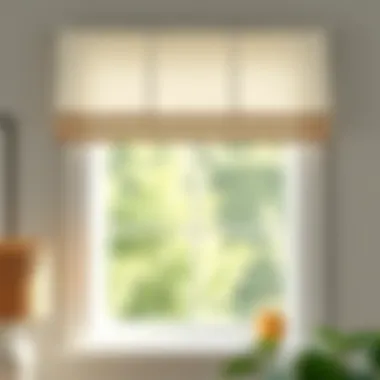

Functional Aspects
Beyond their visual appeal, small window valances are practical. They fulfill functional needs that are often overlooked in discussions about window treatments. For the discerning homeowner, understanding the functional benefits can influence choices significantly.
- Light Control: While valances don’t provide full privacy like drapes do, they can still help control light entering the room. For example, a lined valance can block harsh sunlight, protecting furnishings while still allowing diffused natural light.
- Concealing Hardware: These little heroes can skillfully hide curtain rods and other hardware, creating a tidy appearance. A well-placed valance draws attention away from any unsightly mechanisms and emphasizes the overall design of the window treatment.
- Insulation: Believe it or not, small valances can also aid in insulation. By covering the tops of the windows, they can help keep drafts at bay, especially when paired with another treatment, like blinds or shades.
- Budget-Friendly: When looking to spruce up interiors without breaking the bank, valances are a superb option. They require less fabric than full drapery, meaning lower costs and less fabric waste.
"A well-designed valance can be the unexpected spark that ties a room together, marrying functionality with aesthetic appeal."
Materials for Valances
When considering small window valances, the materials chosen play a significant role in achieving both practicality and style. The right fabric not only enhances the aesthetic of a room but also contributes to the durability and usability of the curtains. Different materials bring unique qualities to the table, providing homeowners with a wide array of choices to suit their decor and functional needs.
Understanding the characteristics of each type of fabric is key. Natural fabrics, such as cotton and linen, evoke a sense of warmth and authenticity, while synthetic materials, like polyester, offer strength and versatility. The blend of various fibers often gives rise to innovative options that combine the best aspects of both worlds.
Fabric Choices
Cotton and Linen
Cotton and linen have long held a place in textile history, renowned for their breathable nature and comfortable feel. These fabrics are highly regarded for their ability to allow air to circulate. This makes them a wonderful option for valances in warmer climates, or in homes with plenty of natural light where heat can build up.
A key characteristic of cotton and linen is their natural texture, which adds depth to window treatments. Moreover, they’re available in a slew of colors and patterns, meaning you can find something that suits virtually any style. However, these fabrics can wrinkle easily, requiring a bit more upkeep to maintain their intended shape.
Polyester and Blends
Polyester and its blends are often seen as the workhorses of the fabric world. They are not just durable but also resistant to fading, wrinkling, and stretching. This means that a polyester valance can look fresh and vibrant even in high-traffic areas of your home, where sun exposure can be an issue.
The versatility of polyester doesn’t end there. It can mimic the look and feel of more expensive fabrics like silk or cotton while being far more affordable and easier to care for. Nonetheless, one must consider its lower breathability compared to natural fabrics; it might not be the best choice in environments where airflow is crucial.
Silk and Velvet
Silk and velvet radiate luxury and richness, ideal for creating a statement in spaces requiring elegance, such as a master bedroom or formal dining room. The way silk catches the light and reveals shifting colors adds a layer of complexity to any window treatment. Velvet, known for its plush feel, can transform a simple valance into an eye-catching focal point.
However, these delightful materials come with their own set of challenges. Both silk and velvet require special care, especially when it comes to cleaning. They are susceptible to water stains and might fade in direct sunlight. Therefore, while they serve a purpose in enhancing the appearance of small windows, their care must be taken into careful consideration.
Natural vs. Synthetic Textiles
When selecting materials, homeowners must grapple with the choice between natural and synthetic textiles. Natural textiles, including cotton and linen, generally offer an eco-friendlier footprint. Conversely, synthetic textiles such as polyester provide higher durability and resistance to environmental factors, making them more practical in some instances.
This decision impacts everything from sustainability to maintenance. Natural textiles feel softer but often require more upkeep, while synthetics might be easier to wash but can lack that cozy, inviting feel of their natural counterparts.
Innovative Materials
The world of fabric is ever-evolving, and innovative materials are beginning to make a splash in the market for valances. For example, recycled polyester, made from plastic bottles, is gaining popularity for its environmental benefits while still providing the easy maintenance associated with traditional polyester. Additionally, performance fabrics designed to resist stains and fading have become sought after for their long-lasting aesthetic appeal.
Whether opting for a classic or an innovative material, selecting the right textile for your small window valances can significantly enhance the overall interior design. In light of various factors such as durability, maintenance, comfort, and aesthetic appeal, the journey of choosing materials is both critical and rewarding.
Design Styles of Valances
Design styles of valances can profoundly influence the overall look of a room. They serve not only as window coverings but also as significant design statements that tie together the aesthetics of a space. When choosing a valance, homeowners must consider not just the design but also how it complements existing decor, the light it filters, and its functional aspects. By understanding varied design styles, you can better harness their potential to elevate the decor of any room.
Traditional Styles
Scalloped Valances
Scalloped valances epitomize timeless elegance and are often chosen for their soft, flowing lines. The key characteristic of scalloped valances is their rounded edges, which provide a gentle contrast to straight lines found in other furnishings. Their graceful form can often make windows appear larger, adding a cozy vibe to spaces like kitchens or sunrooms.
However, while they befit traditional settings splendidly, scalloped valances can also blend within eclectic decors, especially when combined with modern patterns. The unique feature of these valances is their versatility—through fabric choices, they can shift from a rustic charm to a more refined look. A potential disadvantage lies in their intricate design, which might not appeal to those favoring minimalism.
Cascade Valances
Cascade valances are another classic choice, making a bold statement with their layered, cascading style. These valances often drape down in folds, offering a luxurious appearance. Their key characteristic of dramatic draping can add depth and dimension to any window treatment, creating a profound visual focal point. Due to their abundance of fabric, cascade valances work best in larger rooms where they won’t overwhelm the space. A favorable aspect is their ability to soften sunlight streaming in, tailoring the light to create a warm atmosphere. However, like scalloped valances, they require a bit more maintenance and care to keep them looking pristine.
Contemporary Designs
Geometric Patterns
In the realm of contemporary design, geometric patterns emerge as a favored choice for small window valances. The clean lines and bold shapes typical of these patterns can lend a modern flair to any room. Their significant aspect is the ability to bring a sense of rhythm and interest around windows without being overly distracting. Geometric valances can also be playfully mixed with other patterns, providing a fresh and energetic style. A unique benefit of this design is the variety available—colors and shapes can be tailored to harmonize or contrast with other decor elements. Yet, the drawback might be their tendency to date quicker than solid or more timeless patterns.
Sleek Lines
Sleek lines define contemporary valances succinctly, providing a minimalist approach to window dressing. These styles emphasize functionality without compromising elegance. The streamlined shape of sleek line valances works well in modern interiors where excess is avoided. Their ability to blend seamlessly into the background while enhancing a room’s height or width is a key advantage. Moreover, such designs often allow for effortless coordination with blinds or shades, yielding a cohesive look. However, one might argue that the simplicity could lack the warmth found in more intricate designs, which might not appeal to everyone.
Eclectic and Bohemian
Eclectic and bohemian styles open the door to creative expression, inviting homeowners to mix and match fabrics, colors, and patterns. Valances in these styles offer unlimited possibilities, allowing individuals to reflect their personality and stories through decor. They often employ rich textures and layered fabrics, giving an inviting, lived-in feel. The designs can vary widely, making it easy to create a unique window treatment suited to the homeowner’s taste while keeping a casual atmosphere. However, the challenge lies in achieving balance; excessive mixing can lead to visual clutter. Therefore, an eye for harmony amid diversity is essential.
Color Schemes and Palettes
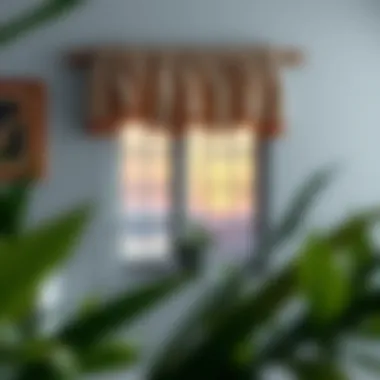

When it comes to small window valances, the color schemes and palettes are a crucial aspect that can significantly influence the overall ambiance and style of any room. Unlike larger window treatments, such as curtains, valances serve as accents that can subtly enhance your decor while providing functionality. Choosing the right colors and patterns not only elevates the aesthetics but also ties together other elements within your space.
Neutral Tones
Neutral tones have a timeless charm that speaks to elegance and simplicity. Think beige, soft grays, and creamy whites. These shades provide a serene backdrop that can create a calm atmosphere in any room. Neutral valances are like chameleons; they can match with virtually any style or color scheme without overwhelming the space. They’re especially effective in smaller rooms where you want to avoid visual clutter. Plus, they work hand in hand with other decor elements, allowing a seamless flow throughout your home. While opting for neutral tones, consider the texture of the fabric as well. A linen valance in a soft beige might add a rustic charm, while a sleek cotton valance in light gray can bring a modern touch. This balance between fabric texture and color plays an essential role in marrying digital warmth with the room’s overall design.
Bold Colors
On the other hand, bold colors can be a delightful way to infuse life into your decor and express personal style. Think about rich jewel tones like emerald green, deep navy, or vibrant fuchsia. These colors demand attention and can serve as focal points in a room. A bright, floral valance can lift the mood of a space and add a touch of playfulness. Don't hesitate to experiment with colors that complement your existing decor or even introduce a fresh perspective. If your color palette is predominantly muted, a bold valance can act as a stunning counterpoint, drawing the eye and creating a layered visual experience. Pairing a bold valance with neutral walls allows the color to pop without becoming too overpowering. Remember, it’s all about balancing vibrancy with restraint.
Pattern Mixing
Pattern mixing can elevate your window treatments and push your creative boundaries. Imagine combining a striped valance with polka-dot curtains; they might seem like odd partners, but with the correct balance, they can complement each other beautifully. Mixing patterns is essential in making a statement without veering into chaos. When considering pattern mixing, think about scale. A large geometric pattern on a valance paired with smaller floral prints in the room creates visual interest without clashing. It's also vital to maintain a cohesive color scheme throughout. Picking patterns that share one or two common colors will help create harmony in your overall look. This approach lets you express your individuality while still painting a coherent picture. Also, don’t shy away from using prints that tell a story—patterns inspired by nature can evoke a sense of calm and bring the outdoors inside.
Tip: When embarking on pattern mixing, test your combinations on a smaller scale before fully committing to your design choice. This way, you can see how the elements blend in the context of your room.
In essence, understanding color schemes and palettes provides an opportunity to express creativity and individuality through valances. Take the time to carefully consider your options, and you’ll find that the right choice can transform your space into a harmonious, stylish retreat.
Incorporating Valances into Different Rooms
In the realm of home decor, small window valances hold a unique position. They effortlessly bridge functionality with style, allowing homeowners to express their creativity while enhancing the practical aspects of window treatments. When thoughtfully incorporated into different rooms, valances can define the atmosphere, unify a design scheme, and draw attention to vistas outside. This section delves into the significance of incorporating valances room by room, considering factors like aesthetics, light control, and overall ambiance.
Kitchen and Dining Areas
In kitchens, small window valances often serve a dual purpose. Not only do they complement the decor, but they also play a pivotal role in managing light and privacy. A valance above a kitchen sink window can soften the harshness of sunlight.
- Fabric Choices: Opt for durable fabrics like cotton or polyester that withstand humid environments.
- Design Inspiration: Patterns such as gingham or floral prints can evoke a cozy, country feel.
- Practical Considerations: Ensure the valance is easy to clean and maintain, given the likely presence of cooking splatters.
In dining areas, the right valance can elevate the dining experience. A rich, elegant fabric paired with a simple, clean line might create a sense of sophistication during mealtimes. It’s all about setting the right tone for gatherings and intimate dinners.
Living Rooms
Living rooms are where magic happens. They reflect the homeowner's personality and style. A well-placed valance can add to this allure. Consider using valances to frame the view, drawing the eye towards the window while softening the edges created by blinds or sheer curtains.
- Design Elements: Layering a valance over a set of drapes can provide depth and texture, enhancing the overall visual interest of the room.
- Color Coordination: Choosing valances that echo the room's color scheme can tie elements together, creating a cohesive look. This might mean selecting a shade that connects with a prominent feature like a sofa or artwork.
- Functional Considerations: Valances can control how much light filters into the room, allowing for flexibility depending on the time of day and mood desired.
Bedrooms
In bedrooms, valances can create a serene and inviting atmosphere. They can serve as a frame for sleep, ensuring that privacy is achieved without sacrificing light. The choice of fabric and design style should resonate with the bedroom's tranquil nature.
- Soft Fabrics: Velvet or silk may lend a more luxurious feel, while cotton remains practical and easy to wash.
- Calming Colors: Soft pastels or earth tones can enhance relaxation, while bolder colors tend to create more drama and energy.
- Placement: Installing valances slightly above the window frame can provide the illusion of taller ceilings, making the room feel more spacious.
Home Offices
Balancing professionalism with comfort is key in home offices. The right valance can foster a productive environment while maintaining aesthetic appeal. A simple, understated fabric can create a sense of focus, especially in a room that may be used for extensive periods of work.
- Material Considerations: Sturdier materials can stand up to daily use, while still allowing for a polished appearance.
- Design Choices: Opting for geometric patterns or solid colors can create a modern feel that inspires creativity.
- Light Control: Valances can help diffuse excess sunlight, reducing glare on screens while still allowing natural light to filter in, promoting a pleasant working atmosphere.
DIY Small Window Valance Projects
When it comes to dressing up those petite windows, DIY small window valances can be the cherry on top of your home decor. Not only do they bring an element of personal creativity into your space, but crafting these window accents yourself can also save a pretty penny. Plus, it’s a fantastic way to inject a bit of your unique flair into a room while having fun in the process. In these projects, you can honor sustainability and personalize your decor—what's not to love about that?
Simple Fabric Valances
Creating simple fabric valances is like piecing together a puzzle with the fabric of your choice. Start with a straightforward rectangular piece that fits your window’s width. A good rule of thumb is to make it about one and a half to two times the width of the window for that nice, gathered look. Depending on your expertise level, you can easily hem the edges for a clean finish! Using cotton or linen with fun patterns, you can add a splash of color or warmth to any room.
"The right fabric can transform even the most mundane space into a haven of style and comfort."
To hang your valance, you might consider a curtain rod or tension rod, which is easily adjustable. This flexibility allows you to switch things up whenever the mood strikes. If you desire something a bit more secure, a wooden board can serve as a staple for the fabric, giving it a more structured appearance.
Using Upcycled Materials
In an age where sustainability is paramount, using upcycled materials for your window valance gives old items a breath of new life. Think out of the box—old tablecloths, shower curtains, or even fabric remnants from previous projects can become charming valances. You don’t need to stick to traditional aesthetics either; combining eclectic patterns and textures can create a bohemian vibe in a jiffy.
One idea could be to sew together pieces of an old sheet and patch it with fun fabric scraps. This not only reduces waste but also adds character as each piece tells a story of its past. By choosing upcycled materials, you engage in an eco-friendly way of decorating that resonates deeply with many homeowners today.
No-Sew Options
For those who may not have access to a sewing machine—or would rather embrace simplicity—no-sew valance options are your best friend. Fabric adhesive is the star here. You can create a no-sew valance in no time using fabric of your choice and a few crafting supplies.
A common method involves using a fabric glue or even iron-on hem tape. Simply fold and press the fabric to your desired length, use the tape for adhesion, and voila! You’ve got yourself a beautiful window treatment without a single stitch.
Additionally, wooden dowels can come into play for a rustic approach. Wrapping fabric around the dowel and securing it with a tie or bead can yield a chic and clean look. It’s about keeping things handy, easy, and stylish—all at once.
Maintaining creativity at every turn and ensuring functionality, these DIY small window valance projects not only enhance your surroundings but also allow for self-expression, sustainability, and fun. Whether you opt for timeless fabric valances, embrace upcycled treasures, or venture into no-sew methods, the window of opportunity in home decor is wide open.
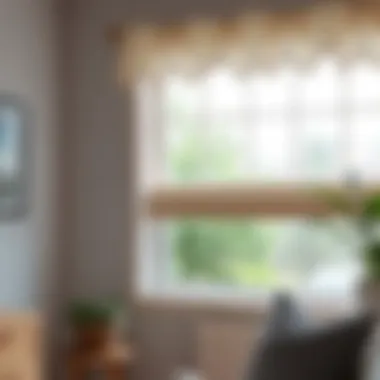

Maintaining and Cleaning Valances
When it comes to enhancing your home decor, small window valances play a pivotal role. They add a touch of style while also managing light and privacy. Yet, to keep them looking their best, proper maintenance and cleaning should never be overlooked. Regular care not only preserves their appearance but extends the life of your valances, keeping your investment worthwhile.
Routine Care
Daily care of valances is simpler than it seems. Dust and dirt can accumulate on the fabric, dulling its vibrancy. Regularly using a soft brush or a lint roller will do wonders in lifting away the grime without damaging the fabric. For those who have valances made from delicate materials like silk, a simple shake or gentle vacuum with a fabric attachment is advisable. Consider the following tips for effective routine upkeep:
- Weekly dusting prevents buildup, especially if your home is in a dusty area.
- Checking for loose hems or stitches will help catch issues before they turn into bigger repairs.
- For fabric types that are washable, a gentle cycle in the washing machine Works wonders, but read the care label first.
Stain Removal Techniques
Stains are a fact of life, especially in a lively household. Responding quickly to spills can mean the difference between a simple cleanup and a major headache. Here are strategies for tackling common stains on your valances:
- Water Stains: Blot the area with a damp cloth. If it persists, mix a bit of white vinegar with water and gently dab.
- Food Stains: For ketchup or sauces, remove any excess with a plastic utensil first, then use a mild detergent and water solution, applying it with a soft cloth.
- Grease Stains: Cornstarch can be your best friend here. Sprinkle a bit on the stain, leaving it to absorb the grease for a few hours before brushing it off. A follow-up with a gentle soap solution will usually do the trick.
"Tackling stains quickly not only preserves the beauty of your valances but will save you from needing to replace them prematurely."
Storage Tips
Should you need to take down your valances—whether for a seasonal change, a room refresh, or moving—storing them correctly is crucial. Here’s how to keep them safe from dust, moisture, and creases:
- Clean Before Storing: Ensure they are laundered or dusted before packing away. Extra dirt or moisture can lead to mildew.
- Use Breathable Fabric Bags: These can help protect against dust without trapping moisture, which is vital for delicate materials.
- Avoid Hanging: Instead of hanging them, roll them neatly. This prevents creasing and makes it easier to unpack later.
Taking the time to care for and maintain your window valances pays off in prolonged use and aesthetic appeal. In a world where home decor is often fleeting, keeping your favorites in mint condition is time well spent.
Valances vs. Other Window Treatments
Understanding how valances stack up against other window treatments is key for homeowners looking to elevate their living spaces. Each type of treatment offers unique benefits, catering to different needs within a home’s decor scheme. Valances, while often seen as mere decorative accents, can actually hold their own against curtains, shades, and blinds, providing a distinctive touch that blends style with function.
Curtains and Drapes
Curtains and drapes have long been staples in home decor, primarily due to their ability to provide privacy while controlling light. They come in a vast array of fabrics, textures, and lengths, making them versatile options for any room. However, they can sometimes feel heavy or overwhelming, particularly in smaller spaces. Here’s a closer look at their characteristics:
- Light Control: Curtains can block out more light than valances, which typically sit above a window, allowing light to filter through the sides.
- Versatility: The variety of styles—from sheer to opaque—means that homeowners have plenty of options to choose from, depending on their specific needs.
- Layering Opportunity: Curtains can be layered with valances for a more dynamic look. This approach enables both functionality and decoration.
Despite these positives, curtains can be cumbersome to clean and maintain, especially in high-traffic areas where dust and dirt accumulate.
Blinds and Shades
Blinds and shades provide excellent functionality for controlling light and privacy. They are a great choice for homeowners looking for minimalistic and sleek designs. Here’s how blinds and shades compare:
- Space-Saving: They are often less bulky than curtains, making them ideal for smaller windows and spaces that require a clean aesthetic.
- Adjustable Light Control: Blinds allow for precise control over light levels by adjusting the slats, while shades can be opened or closed as needed.
- Easy Maintenance: Most blinds and shades can simply be wiped clean, making them practical for busy households.
On the flip side, they may lack the decorative element that valances and curtains can bring. An all-blind approach may come off as overly utilitarian and can cause spaces to feel a little cold or clinical.
Combination Approaches
A combination approach can be the best of both worlds. Utilizing both valances and other window treatments can enhance visual interest and functionality. Below are some effective strategies:
- Layering Valances on Top of Blinds or Shades: This pairing offers the practicality of light control from the blinds, complemented by the soft touch of a valance. The valance can add a splash of color, pattern, or texture, softening the overall look of the window area.
- Balancing Functionality and Aesthetics: For instance, using a sheer curtain with a decorative valance combines both softness and privacy without sacrificing the natural light that floods in.
- Diverse Textures and Patterns: Combining different textures through various window treatments can create depth. A smooth surface from blinds paired with a ruffled valance brings both visual appeal and warmth.
Using a combination approach allows homeowners to create customized solutions that fit their personal style while maximizing light control and privacy.
"Effective window treatments can transform the ambiance of a space; it's not just about functionality, it's also about creating a mood."
In summary, while valances provide a unique and decorative alternative, evaluating how they complement or contrast with curtains, drapes, blinds, and shades will lead to a well-rounded design strategy. The silhouette of the treatment in conjunction with the intended atmosphere of the room is essential in making informed decisions.
Trends in Small Window Valance Designs
Window valances have evolved dramatically over the years, adapting to not just changes in stylistic preferences, but also to broader socio-economic trends. This section delves into the current trends shaping small window valance designs, highlighting sustainability and the integration of technology in fabric design. Understanding these shifts helps create a home that reflects both contemporary sensibilities and the personal tastes of homeowners.
Sustainability in Fabrics
Sustainability has quickly become a leading consideration in all facets of home design, and window treatments are no exception. Using eco-friendly fabrics is not merely fashionable; it aligns with a growing desire for responsible consumption. Materials like organic cotton, hemp, and recycled polyester are gaining traction. These fabrics not only reduce the environmental footprint but also offer inviting textures that enhance the aesthetic appeal of small window valances.
Benefits of opting for sustainable fabrics include:
- Reduced Chemical Use: Organic fabrics avoid harmful pesticides and chemicals, promoting healthier living spaces.
- Durability: Many sustainable materials are designed to last longer than conventional options, offering great value over time.
- Versatility: Creative minds can employ these fabrics in various styles, from rustic chic to modern minimalism.
Choosing such materials also speaks volumes to guests about a homeowner's values. As an anecdotal touch, a friend of mine converted their home office with a beautiful upcycled fabric valance, and it became an instant conversation starter, highlighting how sustainability can touch lives in unexpected ways.
"Embracing sustainability isn't just about looking good; it's about feeling good and making choices that reflect moral conviction."
Technology in Fabric Design
Technology has revolutionized the textile market, enabling designers to push boundaries and create fabrics that are functional yet stylish. From innovative weaving techniques to advanced dyeing processes, these developments have enhanced the practicality of small window valances while still keeping them chic.
- Smart Textiles: Imagine valances that can regulate temperature or repel stains. Smart textiles are not just a novelty; they offer practical solutions to everyday issues.
- Digital Printing: This opens up endless possibilities for unique patterns and designs, allowing for customization that can match any interior theme. Digital prints can deliver vibrant colors and intricate designs that are hard to achieve through traditional methods.
- UV Protection: Modern window treatments can incorporate UV-blocking technology to protect furniture and interiors from sun damage while still looking stylish.
As a case in point, many designers are opting for digitally printed valances that allow for striking, unique patterns that can make even the smallest of windows a focal point. Customers appreciate the ease of maintenance that comes with these advanced materials, thus providing a win-win scenario where aesthetics meet functionality.

